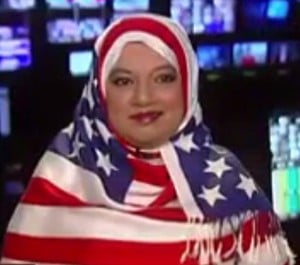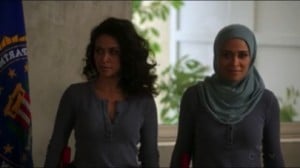I admit, the title put me off a little. Princess Hijab? But when I looked through her flicker albums, I was blown away.
 Princess Hijab is an anonymous 20-year-old guerilla street artist based in Paris, who began her “noble cause” of “hijab-ising” advertisements in 2006. She does this by using spray paint and a black marker to cover women’s faces and bodies in ads, or by pasting “hijab ad” posters everywhere she goes.
Princess Hijab is an anonymous 20-year-old guerilla street artist based in Paris, who began her “noble cause” of “hijab-ising” advertisements in 2006. She does this by using spray paint and a black marker to cover women’s faces and bodies in ads, or by pasting “hijab ad” posters everywhere she goes.
There’s no way of knowing if Princess Hijab is a hijabi. Or even a Muslim. And although I don’t really ‘get’ art, I find her work fascinating. According to her profile page on Art Review:
Princess Hijab explores notions of space and possible types of representation, contrasting the normative representations of the public sphere with her personal iconoclastic approach […] She is known for her subversive work within the public space and for her “diy” and “grrl” attitude.
She takes the veil/ hijab/ chador, which a number of French citizens believe is incompatible with the main principles of French secularism and would prefer it to remain in the private sphere, and brings it firmly into the public sphere. In her own words:
I would say my work is inspired from the anti-consumerist movements. I’m an advertising hijabist. In other words, I cover all advertising with a black veil, which is a dark symbol, a reference on pop culture, and a way to hide elegantly advertising. It is also a study on territories and identities.
So her driving force is anti-consumerism, which ties in to her finding it distasteful for women’s bodies to be used to sell products. She believes she’s “subverting visuals,” though not in an American way, whatever that may be.
She also says that “Princess Hijab knows that L’Oréal and Dark&Lovely have been killing her little by little,” which might also mean that she dislikes being forcefully exposed to bodies everywhere. (Interestingly she’s also hijabised a few men).
But, she’s never said anywhere that she’s doing it because she believes women should be covered yada yada, which I find refreshing. She says that she’s not a member of any political, religious, or anti-ad group, and that she’s only doing this out of a sense of artistic responsibility. And boy, is she artistic! Her art is extremely colorful, funky and comes in all shapes, forms, styles and sizes.
I think I’d actually love it if it turns out she’s not a Muslim, because it lends credibility to the idea that the dislike of being exposed to “visual aggression” is not necessarily rooted in religious belief. Fed up with women being used to sell products, hijabising ads could be a way to “take back” women’s rights to their bodies.
 Her first hijab ad (pictured left), is one many bloggers believe is her self portrait. Quite simply, it’s a poster of an average looking woman in a headscarf (though we can debate her chosen ethnicity), neither smiling nor frowning, with the words “Hijab Ad” written underneath it. A simple, in your face statement which I believe says: “We are here. We exist.”
Her first hijab ad (pictured left), is one many bloggers believe is her self portrait. Quite simply, it’s a poster of an average looking woman in a headscarf (though we can debate her chosen ethnicity), neither smiling nor frowning, with the words “Hijab Ad” written underneath it. A simple, in your face statement which I believe says: “We are here. We exist.”
 Another one of her hijab ads (pictured right) is more controversial, showing a woman in what seems to be a chador, though it ends above her knees and at her elbows. She’s wearing heels, sunglasses, and holding what appears to be a gun.
Another one of her hijab ads (pictured right) is more controversial, showing a woman in what seems to be a chador, though it ends above her knees and at her elbows. She’s wearing heels, sunglasses, and holding what appears to be a gun.
Now, there are a few issues here. The sunglasses and the heels seem to be telling us that just because this woman is covered, her sexuality has not disappeared. The gun could be a metaphor of her strength. Unfortunately, I can’t say that I believe an image of a veiled woman holding a gun would go over very well in France, where instead of being seen as a symbol of feminine power, it might be seen as an instrument of vengeance against the ‘uncovered’ woman. Especially since in her manifesto Princess Hijab writes:
[Princess Hijab] knows all about visual terrorism! […] Make sure that all advertising can be hijabized “‘caus that’s her fight Jihad is her art.”
Chador. Gun. Terrorism. Jihad. Not a good combination.
And although Princess Hijab calls herself the “leader of an artistic fight, nothing else,” it would be simplistic to say that the hijabising of ads is just a protest against showing ‘flesh’ in advertisements. Depending on how you look at her art, it could have deeper implications, and may even help change what hijab represents. The word hijab has been infused with so many meanings—perhaps she’s trying to bring a new dimension to the table. She says:
“The black hijab encompasses every existing form of distinction.”
Deep. In an earlier quote, she said the black veil was a “dark symbol,” which I’m not exactly sure is perhaps the best way to describe it, given the connotations of the word ‘dark.’ She’s also written in her manifesto:
She feels that the veil is no longer that white. She feels contaminated. […] Princess Hijab will go on, veiled and alone, forever asserting her physical and mental integrity. By day, she wears a white veil, symbol of purity. By night, her black veil is the expression of her vengeful fight for a cause.
What do you all think of her white/black veil metaphor? Omar, a blogger from Jordan, writes:
[Princess Hijab] shares her views and artistically discusses the sense of distinction and the submergence of the possible identity, through her portrayal of the generic black-veiled figures that are occasionally presented in this highly-feminine mould. It’s visually striking and it’s causing a stir, yet most importantly a different view from a different perspective. It could turn the hijab into an urban art feminine iconography to voice a number of opinions.
Whatever she’s doing, she’s definitely making an impact. This year, her work was exhibited at the Urban Jealousy Biennale, at the Interkulturel Museum in Norway. It will also be featured in the next issue of the Spanish magazine Fake. Her art has also inspired many artists to follow in her footsteps, using her methods to hijabise many ads.
For more about her, visit her website, though it’s been down for a few days.
All pictures are from Princess Hijab’s Flickr stream.
Update: You may have noticed that we have posted different pictures. We have done so at the request of Princess Hijab. We apologize to our readers for any inconvenience.
Update 2/23/10: The paragraph above was removed due to the fact that the artwork referenced was not by Princess Hijab, but is in fact by MardiNoir. Thank you to Eva Shakouri Torreadrado for notifying us.











